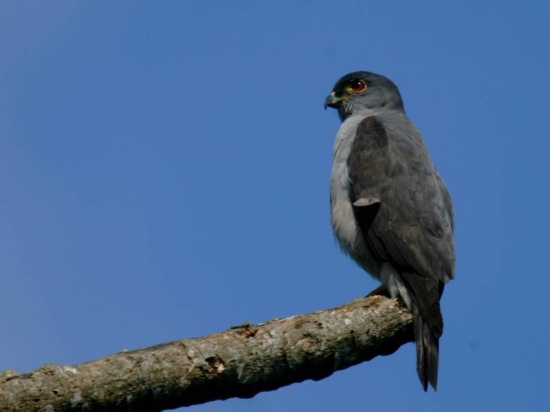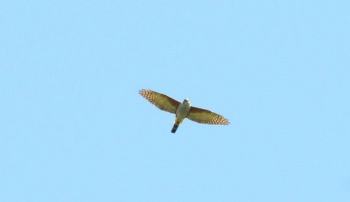(taxon, references, remove {{incomplete}}) |
(Flight picture. Attempt to disguise some copied text. Some deleted text replaced. References updated) |
||
| Line 1: | Line 1: | ||
| − | |||
;[[: Category:Harpagus|Harpagus]] diodon | ;[[: Category:Harpagus|Harpagus]] diodon | ||
| − | [[Image:Rufous-thighed_Kite.jpg|thumb|550px|right|Photo by Jamfaraco<br> | + | [[Image:Rufous-thighed_Kite.jpg|thumb|550px|right|Photo by {{user|Jamfaraco|Jamfaraco}}<br /> Palhoça-SC, [[Brazil]] ]] |
==Identification== | ==Identification== | ||
| − | + | 29–35 cm (11½-13¾ in); shortish wings and a longish tail | |
| − | + | *Slate-grey upperparts | |
| + | *Pale-grey underparts | ||
| + | *Rufous thighs | ||
| + | *Rufous wing-linings | ||
====Similar Species==== | ====Similar Species==== | ||
| + | [[Image:B310.jpg|thumb|350px|right|Photo by {{user|Xyko+Paludo|Xyko Paludo}}<br />Bocaiúva do Sul, PR, [[Brazil]], November 2017]] | ||
[[Double-toothed Kite]] is a big cause of misidentification. | [[Double-toothed Kite]] is a big cause of misidentification. | ||
==Distribution== | ==Distribution== | ||
| − | [[ | + | [[South America]]: from the [[Guianas]] south to eastern [[Bolivia]], [[Paraguay]], southern [[Brazil]] and northern [[Argentina]]. |
==Taxonomy== | ==Taxonomy== | ||
This is a [[Dictionary_M-O#M|monotypic]] species<sup>[[#References|1]]</sup>. | This is a [[Dictionary_M-O#M|monotypic]] species<sup>[[#References|1]]</sup>. | ||
==Habitat== | ==Habitat== | ||
| − | + | Primary lowland rain forests. | |
==Behaviour== | ==Behaviour== | ||
| − | The diet | + | ====Diet==== |
| − | + | The diet consists mostly of insects, particularly cicadas, small birds and lizards. | |
| + | ====Movements==== | ||
| + | This seems to be a migrant breeding in [[Dictionary_A-C#A|austral]] summer in Atlantic Forest and vacating the southernmost part of this range in austral winter which is spent in Amazonian areas. | ||
==References== | ==References== | ||
| − | #{{Ref- | + | #{{Ref-Clements6thAug17}}#Handbook of the Birds of the World Alive (retrieved Dec 2017) |
| + | #Avibirds | ||
{{ref}} | {{ref}} | ||
==External Links== | ==External Links== | ||
Revision as of 23:52, 4 December 2017
- Harpagus diodon
Identification
29–35 cm (11½-13¾ in); shortish wings and a longish tail
- Slate-grey upperparts
- Pale-grey underparts
- Rufous thighs
- Rufous wing-linings
Similar Species
Double-toothed Kite is a big cause of misidentification.
Distribution
South America: from the Guianas south to eastern Bolivia, Paraguay, southern Brazil and northern Argentina.
Taxonomy
Habitat
Primary lowland rain forests.
Behaviour
Diet
The diet consists mostly of insects, particularly cicadas, small birds and lizards.
Movements
This seems to be a migrant breeding in austral summer in Atlantic Forest and vacating the southernmost part of this range in austral winter which is spent in Amazonian areas.
References
- Clements, J. F., T. S. Schulenberg, M. J. Iliff, D. Roberson, T. A. Fredericks, B. L. Sullivan, and C. L. Wood. 2017. The eBird/Clements checklist of birds of the world: v2017, with updates to August 2017. Downloaded from http://www.birds.cornell.edu/clementschecklist/download/
- Handbook of the Birds of the World Alive (retrieved Dec 2017)
- Avibirds
Recommended Citation
- BirdForum Opus contributors. (2024) Rufous-thighed Kite. In: BirdForum, the forum for wild birds and birding. Retrieved 16 April 2024 from https://www.birdforum.net/opus/Rufous-thighed_Kite





